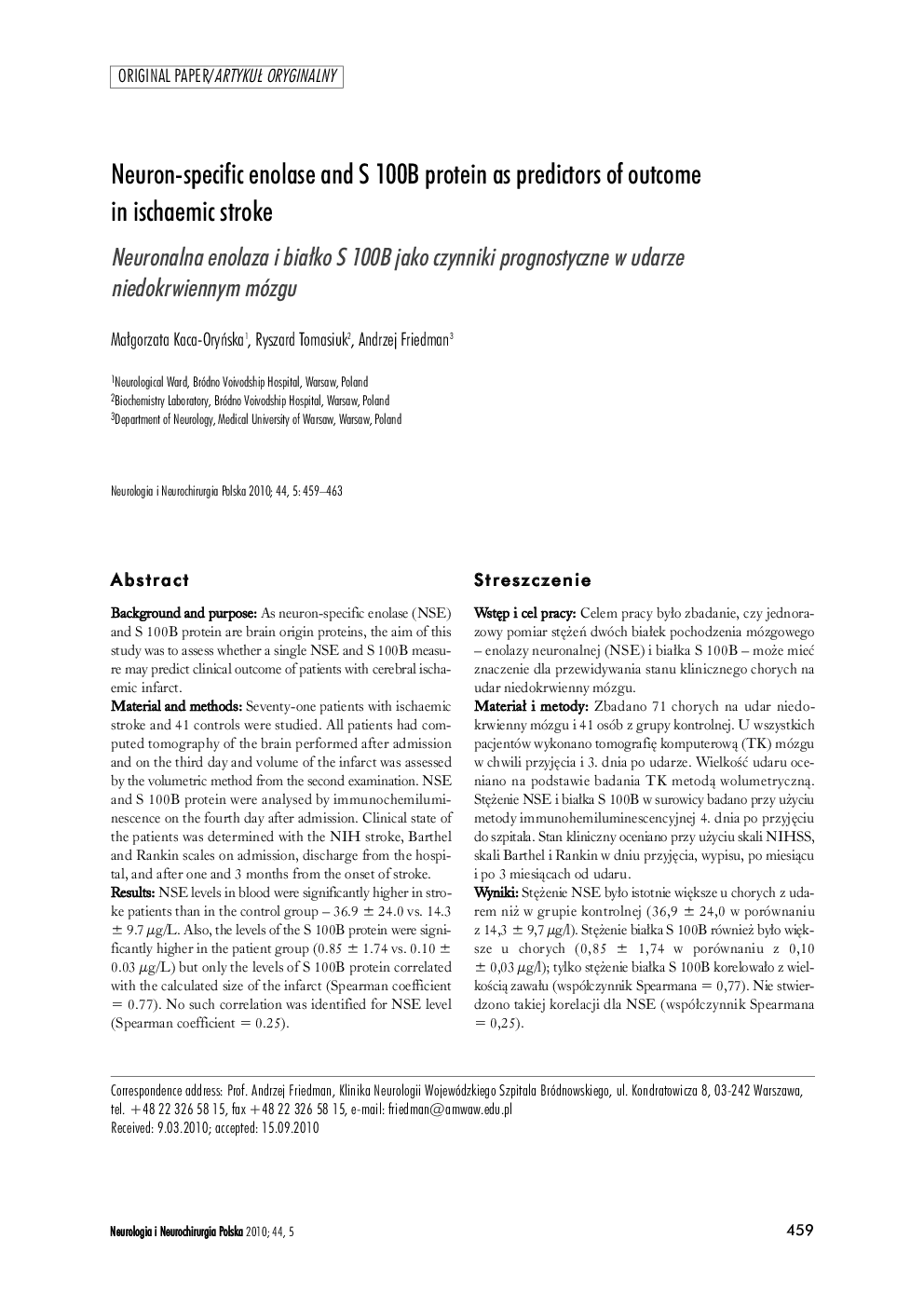| Article ID | Journal | Published Year | Pages | File Type |
|---|---|---|---|---|
| 2153042 | Neurologia i Neurochirurgia Polska | 2010 | 5 Pages |
Background and purposeAs neuron-specific enolase (NSE) and S 100B protein are brain origin proteins, the aim of this study was to assess whether a single NSE and S 100B measure may predict clinical outcome of patients with cerebral ischaemic infarct.Material and methodsSeventy-one patients with ischaemic stroke and 41 controls were studied. All patients had computed tomography of the brain performed after admission and on the third day and volume of the infarct was assessed by the volumetric method from the second examination. NSE and S 100B protein were analysed by immunochemiluminescence on the fourth day after admission. Clinical state of the patients was determined with the NIH stroke, Barthel and Rankin scales on admission, discharge from the hospital, and after one and 3 months from the onset of stroke.ResultsNSE levels in blood were significantly higher in stroke patients than in the control group – 36.9 ± 24.0 vs. 14.3 ± 9.7 μg/L. Also, the levels of the S 100B protein were significantly higher in the patient group (0.85 ± 1.74 vs. 0.10 ± 0.03 μg/L) but only the levels of S 100B protein correlated with the calculated size of the infarct (Spearman coefficient = 0.77). No such correlation was identified for NSE level (Spearman coefficient = 0.25).ConclusionsAlthough significant differences in NSE and S 100B levels between stroke patients and the control group were found, only S 100B protein level correlated with stroke volume, neurological status at admission and functional outcome. NSE did not correlate with stroke volume, neurological status or clinical outcome.
StreszczenieWstęp i cel pracyCelem pracy było zbadanie, czy jednorazowy pomiar stężeń dwóch białek pochodzenia mózgowego – enolazy neuronalnej (NSE) i białka S 100B – może mieć znaczenie dla przewidywania stanu klinicznego chorych na udar niedokrwienny mózgu.Materiał i metodyZbadano 71 chorych na udar niedokrwienny mózgu i 41 osób z grupy kontrolnej. U wszystkich pacjentów wykonano tomografię komputerową (TK) mózgu w chwili przyjęcia i 3. dnia po udarze. Wielkość udaru oceniano na podstawie badania TK metodą wolumetryczną. Stężenie NSE i białka S 100B w surowicy badano przy użyciu metody immunohemiluminescencyjnej 4. dnia po przyjęciu do szpitala. Stan kliniczny oceniano przy użyciu skali NIHSS, skali Barthel i Rankin w dniu przyjęcia, wypisu, po miesiącu i po 3 miesiącach od udaru.WynikiStężenie NSE było istotnie większe u chorych z udarem niż w grupie kontrolnej (36,9 ± 24,0 w porównaniu z 14,3 ± 9,7 μg/l). Stężenie białka S 100B również było większe u chorych (0,85 ± 1,74 w porównaniu z 0,10 ± 0,03 μg/l); tylko stężenie białka S 100B korelowało z wielkością zawału (współczynnik Spearmana = 0,77). Nie stwierdzono takiej korelacji dla NSE (współczynnik Spearmana = 0,25).WnioskiStwierdzono istotne zwiększenie stężeń białek NSE i S 100B u chorych na udar niedokrwienny mózgu w porównaniu z grupą kontrolną, jednak tylko stężenie białka S 100B korelowało z objętością zawału oraz stanem klinicznym zarówno przy przyjęciu, jak i w odległym czasie. Nie stwierdzono takich korelacji dla NSE.
